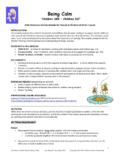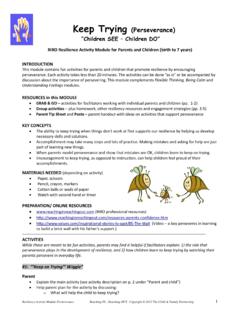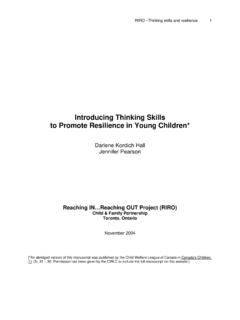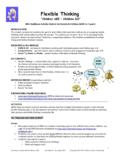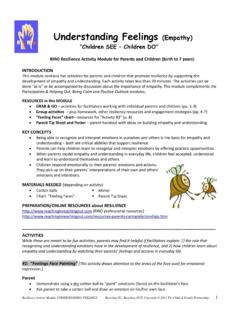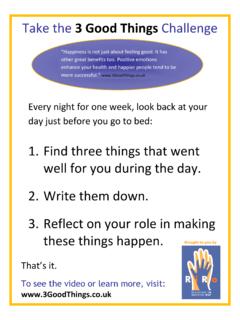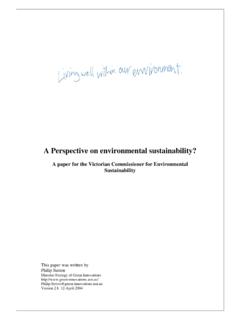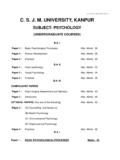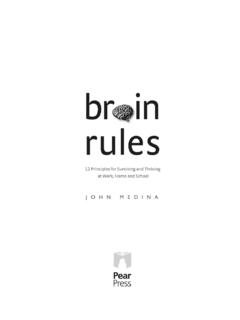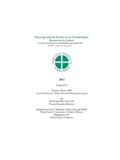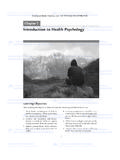Transcription of An Introduction to Resilient Thinking
1 Reaching IN .. Reaching OUTP romoting Resilience in Young ChildrenReaching IN .. Reaching helping children learn to Reach IN to think more flexiblyand accurately and Reach OUT to others and Introduction to Resilient ThinkingRIRO ECE COLLEGE CURRICULUM MODULESR eaching IN .. Reaching OUT (RIRO) An Introduction to Resilient Thinking : RIRO ECE COLLEGE CURRICULUM MODULES Connie Winder George Brown College with contributions from: Darlene Kordich Hall, RIRO Jennifer Person, RIRO Marie Goulet, George Brown College Jennifer Robeson, George Brown College Freya Godard, Godard Communications Child & Family Partnership April 2006 RIRO 2 College Program Curriculum 2006 YMCA of Greater Toronto Child Development Institute George Brown College University of Guelph In the copyright notices throughout this document, the copyright holders are referred to as the Child & Family Partnership.
2 This publication may be photocopied for non-profit educational purposes only. No part of this publication may be transmitted or posted electronically without the written permission of the copyright holders. Electronic copies of these materials may be obtained through the Reaching IN .. Reaching OUT website at ISBN 0-9735278-2-x Instructions for attached DVD: The DVD included in this publication contains the PowerPoints for all three modules as well as the Skills Videos mentioned in Module 2 (p. 22) and Module 3 (p. 39). After inserting the DVD into your computer, it should load the play menu automatically. If the menu does not load, please do the following: 1) Go to Start 2) Go to My Computer. 3) Go to DVD drive and right click 4) Click Autoplay on the menu.
3 5) Choose program to play DVD ( , Windows Media Player) The RIRO play menu should now load. If it still does not load, then do the following to access: Skills Videos: open Windows Media Player. On upper left side of screen, click on down arrow to the right of Now Playing. Then choose CD/DVD and click. The Skills videos menu will appear. PowerPoints: open MS Office PowerPoint. Go to File, then Open, and select your DVD drive and click. The files for each module s slides will be listed. Contents Preface 5 References 5 Module 1: The Importance of Resilience 7 Learning outcomes 7 What is resilience? 8 Why is resilience important? 8 Why is it important for adults working with young children to be Resilient ? 9 What can I do to be more Resilient ?
4 10 Suggested activities 11 References 11 PowerPoint slides 13 Module 2: Cognition and Emotion: The ABC Model 15 What is the relationship between cognition and emotion? 16 Are thoughts always involved in emotions? 16 How are cognition and emotions related to resilience? 17 What is the ABC model? 18 How can the ABC model be used? 19 How do I identify my beliefs? 19 What do I do when my beliefs are not accurate? 20 Suggested DVD segment 21 Suggested activities 21 Handout 2-1: Generating alternative beliefs 25 References 29 PowerPoint slides 30 Module 3: Explanatory Style and Putting It in Perspective 33 Learning outcomes 34 What beliefs are involved in Resilient Thinking ? 34 How is optimism related to resilience? 34 How is self-efficacy related to resilience? 34 How is hardiness related to resilience?
5 35 Why are our explanations of negative events so important to resilience? 35 What are the dimensions of explanatory style? 35 Why do people feel compelled to explain negative events in their lives? 36 Why do we develop reflexive habits of Thinking ? 37 RIRO ECE College Program Curriculum 3 2006 Child & Family Partnership Contents (see p. 2) Why do some people develop a negative explanatory style? 37 How can we increase the accuracy of our explanations of negative events? 37 How do I put it in perspective? 38 Suggested DVD segments 39 Suggested activities 40 References 43 PowerPoint slides 45 Project Overview 47 What is the Reaching IN.
6 Reaching OUT project? 47 What research has been conducted so far? 48 What are the research results thus far? 48 What is the purpose of the RIRO ECE College Program Curriculum? 49 Where can I find additional resource materials about resilience and the RIRO project? 49 RIRO ECE College Program Curriculum 4 2006 Child & Family Partnership Content (see p. 2) RIRO ECE College Program Curriculum 5 2006 Child & Family Partnership Preface (see p.)
7 2)Preface Resilience in development has been described perfectly by Ann Masten (2001) as ordinary magic. Resilience in children does not come from rare or extraordinary qualities, but from everyday basic human resources, such as relationships with competent and caring adults in the family and community, cognitive and self-regulation skills, positive views of oneself, and the motivation to affect the environment. The extraordinary protection offered by these ordinary processes is magical. The Reaching IN .. Reaching Out (RIRO) ECE College Curriculum Modules provide opportunities for students to examine their own resilience. Students are encouraged to explore their own reactions to stress and to develop further the accuracy and flexibility of their Thinking . These draft modules have been designed to be used within the ECE college curriculum wherever they might best fit.
8 They by no means purport to encompass all that ECE students will learn to do in order to promote the development of resilience and flexible adaptation in young children. The student s ability to develop caring and responsive relationships with children, to understand child development, to support families, to respect individual differences, and to engage each child in active exploration are all fundamental to the nurturing of resilience. The aim of these draft modules is to increase the salience of Thinking skills as an integral part of resilience. The modules introduce students to the concept of resilience and to the role Thinking plays in overcoming the inevitable stress and adversity of life. Showing how our Thinking affects our emotional responses and our coping skills is a good first step in helping early childhood education students to develop their own resilience and to model accurate and flexible Thinking for the children and families they serve.
9 We welcome your comments. Please visit the RIRO web site at for contact information. References Masten, A. (2001). Ordinary magic: Resilience processes in development. American Psychologist, 56(3), 227 238. RIRO ECE College Program Curriculum 6 2006 Child & Family Partnership Preface (see p. 2) RIRO ECE College Program Curriculum 7 2006 Child & Family PartnershipModule 1: The importance of resilience (see p. 2)Module 1: The Importance of Resilience A young, athletic, spirited teenager who loved sports was returning home after an afternoon of fishing with his friends when the truck he was riding in went out of control and crashed.
10 He survived the accident but was told he would never walk again. He was 15 years old. Imagine how that would change a person s life. At first he was deeply despondent, but somehow he persevered. With hard work and determination he finished high school and was the first student with a physical disability to graduate from the University of British Columbia with a degree in physical education. He went on to win 19 international wheelchair marathons and compete for Canada in the 1984 Olympics. Realizing that he might be able to change the way that people with disabilities were perceived, and inspired by his friend Terry Fox, he toured the world in his wheel-chair to raise awareness of, and money for, research into spinal cord injuries, rehabilitation, and wheelchair sports. He founded the Man in Motion Foundation and the Rick Hansen Institute, which have raised more than $118 million for a wide range of charitable and research activities associated with spinal cord injuries.

